Gluten-free honey oat bread is a wholesome, delicious alternative to traditional loaves that blends the natural sweetness of honey with the hearty texture of oats—all without the gluten. Whether you’re managing celiac disease, have gluten sensitivity, or simply want to eat cleaner, this soft and subtly sweet bread is a perfect fit for your lifestyle. It’s easy to make at home, packed with nutrients, and doesn’t compromise on flavor or texture like some store-bought gluten-free breads often do.
More than just a trendy baking project, gluten-free honey oat bread is a nutritious staple you can enjoy for breakfast, snacks, or light lunches. From understanding its health benefits to mastering the best baking techniques, this guide covers everything you need to know. We’ll break down the ingredients, share variations, teach you how to store it, and even answer common questions people ask before making the switch to this naturally sweet, gluten-free classic.
Table of contents
- Introduction to Gluten-Free Honey Oat Bread
- Health Benefits of Gluten-Free Ingredients
- Choosing the Right Ingredients for the Perfect Texture
- Step-by-Step Guide to Making Gluten-Free Honey Oat Bread
- Baking Tips to Avoid Common Mistakes
- Gluten-Free Honey Oat Bread Variations
- Serving Ideas and Pairings
- FAQs About Gluten-Free Honey Oat Bread
- Conclusion
Introduction to Gluten-Free Honey Oat Bread
What is Gluten-Free Honey Oat Bread?
Gluten-free honey oat bread is a soft, golden-brown loaf made with certified gluten-free oats, gluten-free flour blends, and naturally sweet honey. It’s a nutrient-dense alternative to traditional wheat-based bread and offers a wholesome, comforting taste with every bite. Unlike many gluten-free breads that can turn out dense or crumbly, this recipe balances texture and moisture beautifully, thanks to the addition of honey and oats.
Whether you’re living a gluten-free lifestyle out of necessity or by choice, this bread stands out for its simplicity and flavor. It’s perfect for those who miss the fluffy texture of wheat bread but can’t tolerate gluten. Gluten-free honey oat bread can be enjoyed on its own, toasted with butter, or paired with savory or sweet toppings for any meal of the day.
Why This Bread is Perfect for a Healthy Lifestyle
Gluten-free honey oat bread isn’t just about avoiding gluten—it’s about embracing cleaner, more nourishing ingredients. Oats provide a great source of fiber, keeping you full longer and supporting digestive health. When paired with natural honey, you get a touch of sweetness without the need for refined sugars. This combination makes the bread suitable for breakfast, post-workout snacks, or even a quick lunch.
Unlike commercial bread loaded with additives, baking your own gluten-free honey oat bread lets you control every ingredient. You can use organic oats, raw honey, and even dairy-free milk to fit specific dietary needs. Plus, you avoid preservatives and processed ingredients commonly found in packaged bread, making it a smarter choice for long-term health and wellness.
Bake up a sweet, fruity treat with this moist and delicious Peach Bread recipe—perfect for breakfast or dessert!
Health Benefits of Gluten-Free Ingredients
Nutritional Perks of Gluten-Free Oats and Natural Honey
The core ingredients in gluten-free honey oat bread aren’t just tasty—they offer real health benefits. Certified gluten-free oats are packed with fiber, particularly beta-glucan, which is known to support heart health, stabilize blood sugar, and improve digestion. They’re also rich in vitamins like B1, magnesium, and antioxidants, giving your body a nutrient boost with every slice.
Honey, especially raw or unprocessed types, brings more than sweetness to the loaf. It has natural antibacterial properties, enzymes, and antioxidants that help reduce inflammation and support immune health. When used in moderation, honey is a healthier alternative to refined sugar, adding flavor depth while delivering trace nutrients like iron and zinc.
Combining these ingredients in gluten-free honey oat bread means you’re not just avoiding gluten—you’re actively choosing ingredients that nourish your body and support your wellness goals.
Benefits of Eliminating Gluten from Your Diet
For many people, removing gluten from their diet leads to better digestion, reduced bloating, and increased energy levels. Those with celiac disease or non-celiac gluten sensitivity experience significant health improvements when switching to gluten-free options like gluten-free honey oat bread. But even if you’re not gluten intolerant, reducing gluten can still have benefits.
Modern wheat is often processed and stripped of nutrients. By focusing on gluten-free grains like oats and buckwheat, you’re tapping into whole foods that are easier to digest and closer to their natural form. This helps improve gut health and can reduce chronic inflammation over time. Plus, it encourages more mindful eating—when you bake your own bread, you naturally become more aware of what’s fueling your body.
Choosing the Right Ingredients for the Perfect Texture
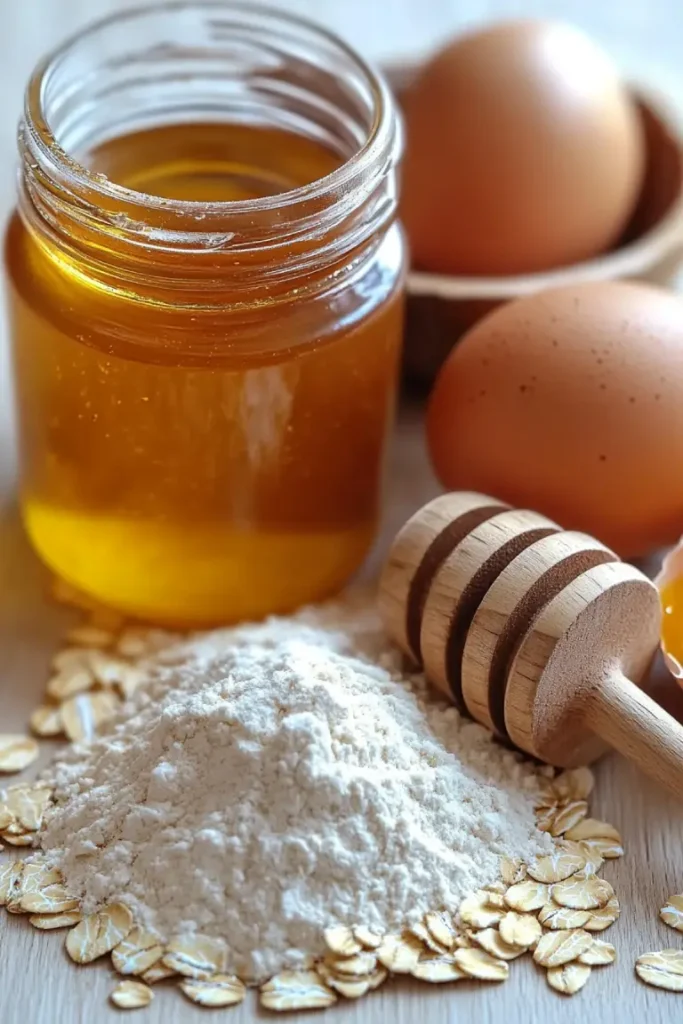
Best Types of Certified Gluten-Free Oats and Flour
When making gluten-free honey oat bread, the ingredients you choose can make or break the final result—especially when it comes to texture. Not all oats are truly gluten-free. To avoid cross-contamination, always look for certified gluten-free rolled oats or quick oats. Rolled oats provide a chewy, hearty bite, while quick oats blend more smoothly into the dough, giving the loaf a softer texture.
As for the flour base, a high-quality gluten-free all-purpose flour blend works best. Choose one that includes a balance of rice flour, tapioca starch, and potato starch. These components mimic the elasticity of wheat, helping your bread rise better and hold together without crumbling. Some blends even contain xanthan gum, which adds structure and chewiness—a must-have for achieving bakery-style results.
To enhance the bread’s fiber and protein profile, you can mix in oat flour, almond flour, or a bit of buckwheat flour. Just be sure to adjust the liquid ratios, as these flours absorb moisture differently.
How Honey Impacts Flavor and Moisture Retention
In gluten-free honey oat bread, honey serves two purposes: sweetener and moisture enhancer. Unlike refined sugar, honey attracts and retains moisture, helping keep your loaf soft for days. This is especially important in gluten-free baking, where dryness can be a common issue.
Flavor-wise, honey adds a natural depth with floral, earthy tones that complement the nuttiness of oats. You only need a small amount to give the bread a lightly sweet profile that works just as well for savory toppings like avocado or nut butters as it does for sweeter spreads like jam.
Using raw or organic honey not only boosts nutritional value but also gives your bread a more complex, natural taste. Avoid using flavored or processed honeys—they can overpower the balance and introduce unnecessary additives.
Step-by-Step Guide to Making Gluten-Free Honey Oat Bread
Essential Equipment and Preparation
Before you begin baking your gluten-free honey oat bread, make sure you have the right tools on hand. Unlike traditional wheat bread, gluten-free dough behaves differently and benefits from precise handling.
Here’s what you’ll need:
- A large mixing bowl
- Measuring cups and spoons
- A whisk or stand mixer with paddle attachment
- A loaf pan (8×4 or 9×5 inches)
- Parchment paper
- A kitchen scale (optional but recommended for accuracy)
Preheat your oven to 350°F (175°C). Lightly grease your loaf pan and line it with parchment paper to prevent sticking and help with an easy release after baking.
Detailed Recipe Instructions with Pro Baking Tips
Ingredients:
- 2 cups certified gluten-free rolled oats (plus extra for topping)
- 1 ¾ cups gluten-free all-purpose flour blend (with xanthan gum)
- 1 ½ teaspoons baking powder
- 1 teaspoon baking soda
- ½ teaspoon sea salt
- 2 large eggs
- 1 cup unsweetened almond milk (or milk of choice)
- ⅓ cup raw honey
- ¼ cup light olive oil or melted coconut oil
- 1 teaspoon apple cider vinegar
Instructions:
- Mix dry ingredients: In a large bowl, combine oats, gluten-free flour blend, baking powder, baking soda, and salt. Whisk until evenly distributed.
- Blend wet ingredients: In another bowl, whisk together the eggs, almond milk, honey, oil, and apple cider vinegar until smooth.
- Combine wet and dry: Slowly pour the wet mixture into the dry ingredients. Mix until fully combined. The batter will be thicker than traditional bread dough—more like a thick cake batter.
- Let it rest: Allow the batter to sit for 10–15 minutes. This step hydrates the oats and activates the baking soda, which improves texture and rise in gluten-free honey oat bread.
- Prepare for baking: Pour the batter into the prepared loaf pan. Smooth the top with a spatula and sprinkle extra oats on top for a rustic finish.
- Bake: Bake for 45–55 minutes or until a toothpick inserted into the center comes out clean. The top should be golden and firm to the touch.
- Cool completely: Let the bread cool in the pan for 10 minutes, then lift it out using the parchment and cool completely on a wire rack. Gluten-free honey oat bread firms up as it cools, so don’t slice too early.
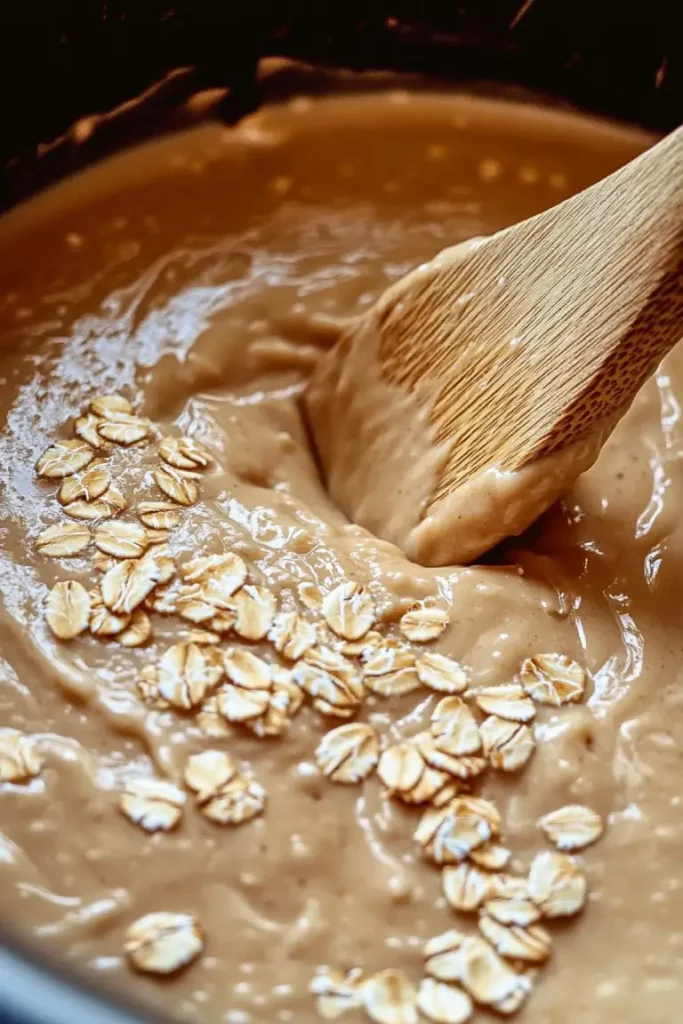
Pro Tip: Want a slightly sweeter loaf? Add a mashed banana or a touch of cinnamon to the batter for a warm, cozy flavor twist.
Bake a wholesome and ancient grain loaf with this easy Einkorn Bread recipe—nutty, hearty, and delicious!
Baking Tips to Avoid Common Mistakes
How to Keep Your Bread Moist and Fluffy
One of the most common struggles in baking gluten-free honey oat bread is achieving that soft, fluffy texture without it drying out or falling apart. Moisture retention is key—and it starts with the ingredients. Using honey and a quality gluten-free flour blend with xanthan gum (or psyllium husk) helps lock in moisture and bind the loaf.
Another tip? Don’t skip the resting time after mixing the batter. Letting the mixture sit for 10–15 minutes before baking allows the oats to soak up liquid, which creates a more cohesive texture once baked. Also, avoid overmixing the batter. Unlike wheat-based doughs, gluten-free batters don’t need heavy kneading—in fact, gentle mixing is best.
During baking, cover your loaf with foil during the last 15 minutes if the top is browning too quickly. This helps prevent the crust from drying out while the inside finishes baking.
Bonus Tip: A water bath in the oven (a shallow pan of hot water on the lower rack) can add steam to the oven, preventing dryness in your gluten-free honey oat bread.
Avoiding Crumbles and Dry Texture in Gluten-Free Baking
A dry, crumbly loaf is the #1 complaint with gluten-free bread. Fortunately, there are several ways to fix this:
- Use the right flour blend: Not all gluten-free flours are created equal. Choose one that includes a balanced mix of rice flour, starches, and a binder like xanthan gum.
- Measure ingredients carefully: Too much flour or not enough liquid leads to dry results. When in doubt, use a kitchen scale for accuracy.
- Incorporate moisture-rich ingredients: Eggs, honey, oil, and non-dairy milk all contribute to a moist crumb. Don’t reduce these amounts unless testing variations.
- Cool before slicing: Cutting into your gluten-free honey oat bread too early will make it fall apart. Allow it to cool completely so the structure can set properly.
Even the most seasoned bakers learn by trial and error, so don’t be discouraged. Each loaf you bake brings you closer to mastering this wholesome, gluten-free staple.
Gluten-Free Honey Oat Bread Variations
Vegan and Dairy-Free Options
One of the best things about gluten-free honey oat bread is how easy it is to adapt for other dietary needs—like going fully vegan or dairy-free. To make a vegan version, replace the eggs with flax eggs (1 tablespoon ground flaxseed + 2.5 tablespoons water per egg, let sit for 5 minutes). These work well to bind ingredients and maintain a moist texture.
Instead of regular milk, use unsweetened almond milk, oat milk, or coconut milk. They add creaminess without overpowering the bread’s flavor. For added richness, a spoonful of applesauce or mashed banana can boost both moisture and natural sweetness—especially helpful when omitting eggs or cutting down on honey.
If you prefer to avoid honey, maple syrup or agave syrup can step in as 1:1 replacements. Just remember, maple syrup adds a slightly different flavor, giving your gluten-free honey oat bread a deeper, earthy sweetness.
Adding Seeds, Dried Fruits, or Spices for Extra Flavor
Once you’ve nailed the basic recipe, it’s time to play. Gluten-free honey oat bread is incredibly versatile and takes well to mix-ins that add both flavor and nutrition.
Here are a few creative add-ins to try:
| Add-In | Benefits | Amount |
|---|---|---|
| Chia or flax seeds | Boost fiber and omega-3s | 2 tbsp |
| Pumpkin seeds | Add crunch and protein | ¼ cup |
| Dried cranberries | Provide a tart contrast to the honey | ⅓ cup |
| Cinnamon or nutmeg | Warm spice that enhances oat flavor | 1 tsp |
| Raisins or chopped dates | Naturally sweet and chewy | ½ cup |
Just fold these into the batter after mixing. Keep total mix-ins under ¾ cup to maintain balance and structure.
Want a more savory take? Try mixing in rosemary, a sprinkle of sea salt on top, or even shredded dairy-free cheese for a hearty snack bread. Whether you’re craving sweet or savory, there’s no limit to how you can personalize your gluten-free honey oat bread.
Serving Ideas and Pairings
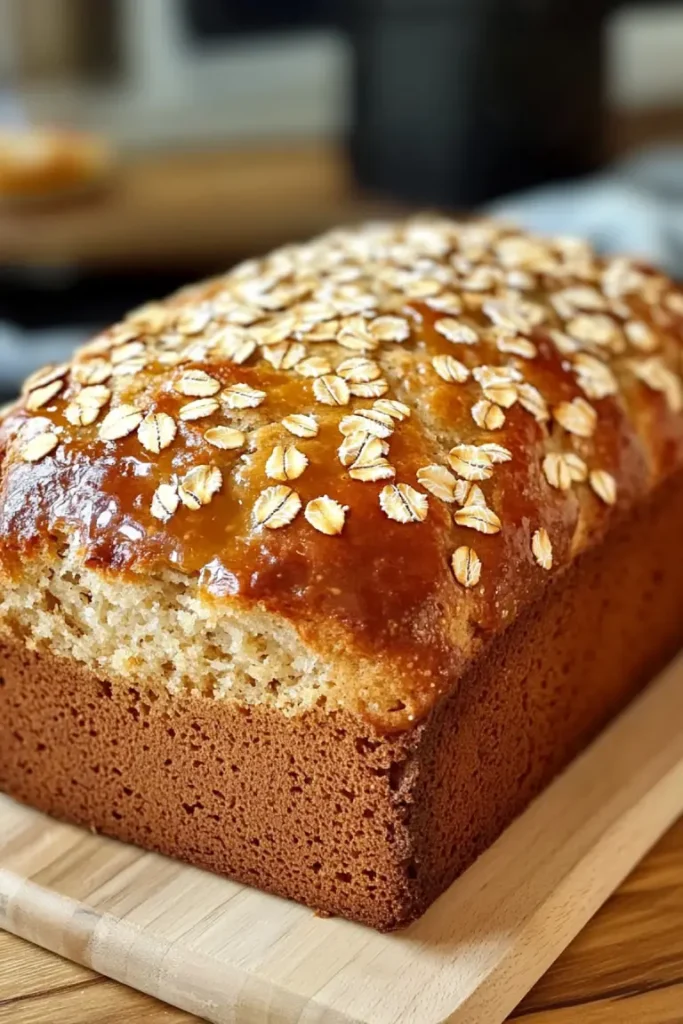
Best Ways to Enjoy Your Gluten-Free Honey Oat Bread
Gluten-free honey oat bread isn’t just a loaf—it’s a canvas for all kinds of tasty creations. Thanks to its mildly sweet, nutty flavor and soft texture, this bread pairs well with both sweet and savory toppings, making it a flexible choice for any meal of the day.
Here are some popular ways to enjoy it:
- Classic Toasted with Butter or Ghee: A simple but satisfying option. Toast enhances the oat flavor while the honey comes through in each bite.
- Avocado & Egg Smash: Top a toasted slice with mashed avocado, sea salt, black pepper, and a soft-boiled egg. Perfect for a hearty breakfast or light lunch.
- Almond Butter & Banana: For a quick energy boost, layer almond butter and banana slices, then drizzle with extra honey or cinnamon.
- Grilled Cheese with a Twist: Use your gluten-free honey oat bread to make a melty, golden grilled cheese. Add a slice of tomato or apple for contrast.
- French Toast: Yes—this bread makes amazing gluten-free French toast. Dip slices in an egg and milk mixture, cook on a skillet, and top with fresh berries and maple syrup.
Whether you need a quick snack or a nourishing breakfast, gluten-free honey oat bread is a dependable option that elevates the everyday.
Healthy Toppings, Sides, and Breakfast Pairings
Want to keep it nutritious while still enjoying every bite? Pair your gluten-free honey oat bread with wholesome toppings and sides that fuel your day without weighing you down.
Here are some health-conscious pairings:
| Meal Time | Pairing Idea |
|---|---|
| Breakfast | Greek yogurt with fruit + toasted bread + chia seeds |
| Post-Workout | Nut butter on bread + protein smoothie |
| Lunch | Open-faced tuna salad sandwich on toasted slice |
| Snack | Cottage cheese + sliced tomatoes on bread |
| Dessert | Toasted with ricotta + a drizzle of raw honey |
These combinations provide balance—protein, fiber, healthy fats—and make every bite of gluten-free honey oat bread even more satisfying.
Add a tropical twist to your baking with this moist and flavorful Hawaiian Banana Bread recipe—perfect for breakfast or snacking!
FAQs About Gluten-Free Honey Oat Bread
Is oat and honey bread healthy?
Yes, oat and honey bread—especially when made gluten-free—is a nutritious choice for most people. Gluten-free honey oat bread contains whole grain oats, which are rich in fiber, and honey, which provides natural sweetness without refined sugar. It’s a clean-eating option that supports heart health, aids digestion, and helps with steady energy levels throughout the day. Compared to store-bought bread filled with additives, this homemade version gives you full control over the ingredients.
Is oat bread lower in gluten?
Traditional oat bread made with regular oats and wheat flour is not gluten-free and may still contain significant gluten. However, gluten-free honey oat bread is made using certified gluten-free oats and gluten-free flour blends, making it a safe choice for those with celiac disease or gluten sensitivities. Always double-check that your oats are labeled “certified gluten-free,” as cross-contamination is common in regular oat processing.
Is honey oat bread at Subway healthy?
Subway’s honey oat bread is not gluten-free, and while it contains oats and honey, it’s also made with refined flours and added sugars. Compared to homemade gluten-free honey oat bread, Subway’s version includes preservatives and processed ingredients. If you’re aiming for a healthy, gluten-free lifestyle, baking your own loaf at home gives you a cleaner, more wholesome option without the additives.
Conclusion
Gluten-free honey oat bread is more than just a gluten-free alternative—it’s a wholesome, nourishing staple that fits into a variety of lifestyles. Whether you’re avoiding gluten due to health reasons or simply looking for a cleaner, more nutritious bread to enjoy, this homemade recipe offers the perfect balance of flavor, texture, and flexibility.
With simple ingredients like certified gluten-free oats and natural honey, you can create a loaf that’s soft, slightly sweet, and full of nutrients. Plus, it’s endlessly adaptable—vegan-friendly, dairy-free, mix-in ready, and perfect for freezing.
Love cooking? Find endless inspiration by following butteryrecipes on Pinterest and Facebook!
Print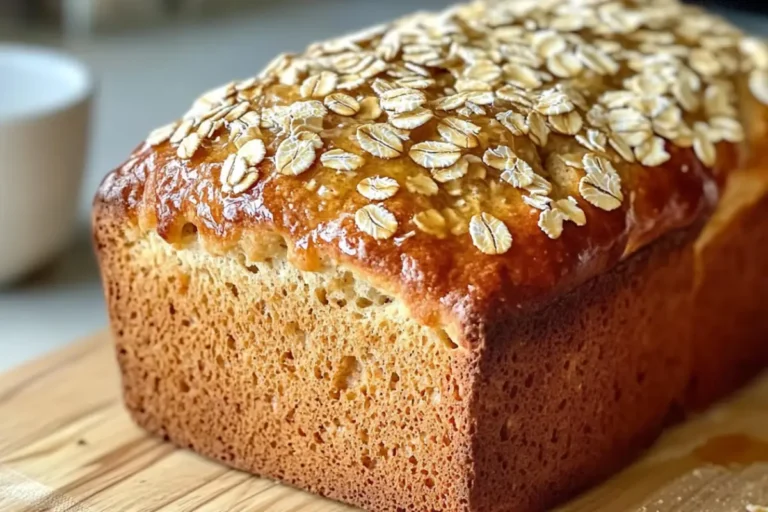
Gluten-Free Honey Oat Bread – 7 Reasons to Love It
A soft, wholesome gluten-free bread made with hearty oats and naturally sweet honey. Perfect for breakfast, snacking, or clean eating lifestyles.
- Total Time: 1 hour 5 minutes
- Yield: 1 loaf (10–12 slices) 1x
Ingredients
- 2 cups certified gluten-free rolled oats (plus extra for topping)
- 1 ¾ cups gluten-free all-purpose flour blend (with xanthan gum)
- 1 ½ teaspoons baking powder
- 1 teaspoon baking soda
- ½ teaspoon sea salt
- 2 large eggs
- 1 cup unsweetened almond milk (or milk of choice)
- ⅓ cup raw honey
- ¼ cup light olive oil or melted coconut oil
- 1 teaspoon apple cider vinegar
Instructions
- Preheat the oven to 350°F (175°C). Grease and line a loaf pan with parchment paper.
- In a large bowl, whisk together oats, flour blend, baking powder, baking soda, and salt.
- In a separate bowl, mix eggs, almond milk, honey, oil, and apple cider vinegar until smooth.
- Pour the wet mixture into the dry ingredients. Stir until fully combined to form a thick batter.
- Let the batter rest for 10–15 minutes to hydrate and activate the leaveners.
- Transfer the batter into the prepared pan, smoothing the top. Sprinkle with extra oats.
- Bake for 45–55 minutes or until a toothpick inserted in the center comes out clean.
- Cool in the pan for 10 minutes, then transfer to a wire rack to cool completely before slicing.
Notes
Use certified gluten-free oats to avoid cross-contamination. Let the loaf cool fully before slicing to prevent crumbling. Add-ins like seeds or dried fruit can be folded in after mixing.
- Prep Time: 15 minutes
- Cook Time: 50 minutes
- Category: Bread
- Method: Baking
- Cuisine: Gluten-Free
Nutrition
- Serving Size: 1 slice
- Calories: 190
- Sugar: 5g
- Sodium: 210mg
- Fat: 7g
- Saturated Fat: 1g
- Unsaturated Fat: 6g
- Trans Fat: 0g
- Carbohydrates: 27g
- Fiber: 3g
- Protein: 4g
- Cholesterol: 25mg
Keywords: gluten-free, honey oat bread, healthy bread, clean eating, homemade bread
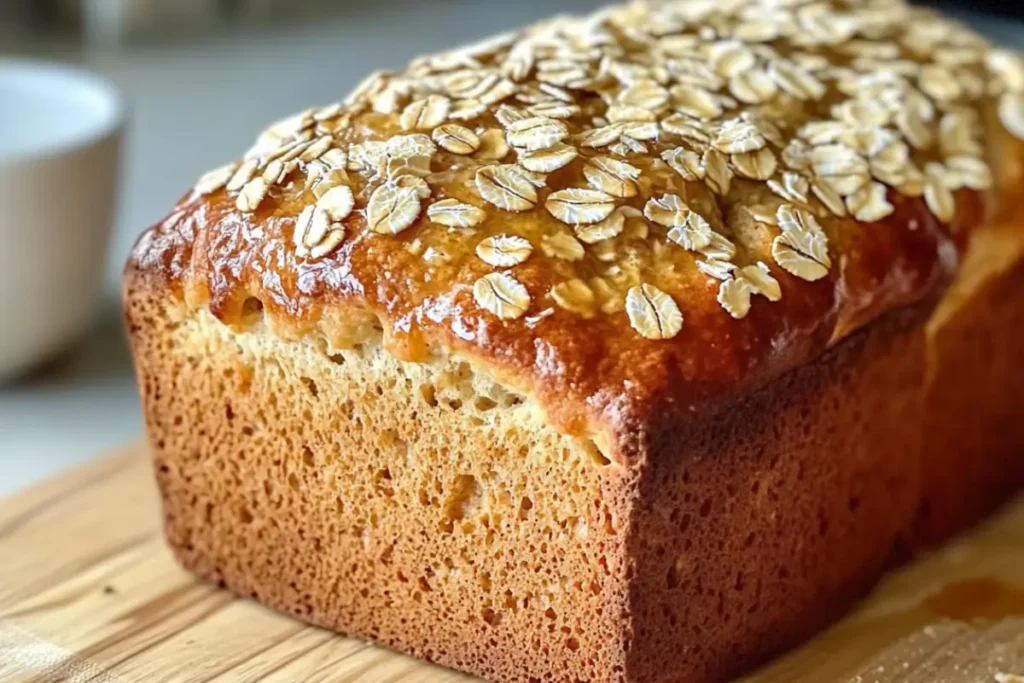
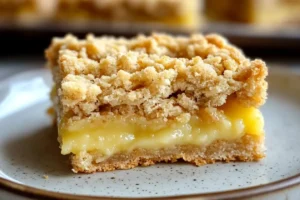


1 thought on “Gluten-Free Honey Oat Bread – 7 Reasons to Love It”